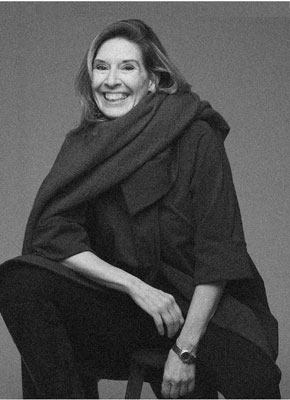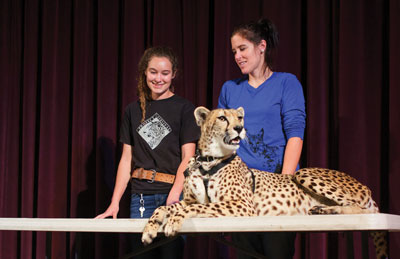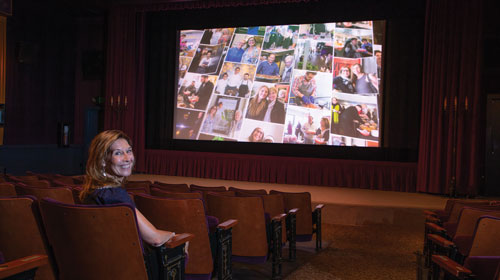In 2005, when Cathy Buck, proprietor of the Cameo Cinema, left Michigan and a 25-year career in real estate, movies were merely a means for entertainment. All of that changed three years later, when Hollywood dreams came a calling.
New to the area, Buck did what most transplants do—she went to work at a winery. But when a friend told her the local theater in St. Helena was up for sale, Buck’s interest was piqued. “I thought: that’s a job anyone can do at any age. And it’s fun. Everybody loves going to the movies.” Buck decided to go for it, and in 2008 she acquired the Cameo from then owner Charlotte Wagner, who had run the theater since 1996.
The storied cinema dates back to 1913, when it first opened its doors as the G&G Theater. It quickly became the cultural center of the small agricultural community. The space would change hands and names many times over the next several decades, which only added to Buck’s enthusiasm. But life in the theater wasn’t as easy as she envisioned. “I thought I was just going to go to the movies and pop the popcorn. It turned out to be the hardest job in the world,” she says. “When I bought the theater, everything was on film. There were three to four reels per can and each movie would have anywhere from six to eight reels. I would have to come in and put them together, splicing one end to the next. It was way outside of my area of expertise.” To further complicate what was supposed to be the easiest job in the world, the nature of screening film dramatically changed a year later. “By 2009 most of the studios were promoting digital cinema. They were pushing it, and rightly so, because the cost of shipping these films was so expensive.”
 Buck saw the wave of the future and knew she had to get in front of it. She reached out to a local organization, Nimbus Arts and the Cantus Foundation, and struck an alliance. “They wanted to do more indie films here and said they would underwrite the [digital] projector.” From that point forward, Buck made it her business to create the ultimate theater going experience—a mission she has never strayed from. Thanks to her hutzpah and the partnership with Nimbus Arts, the Cameo became one of the first theaters in the country to have a digital projector. Buck would spend the next three years screening in both 35 mm film and digital formats before going fully digital in 2013. The transition neatly coincided with the 100-year birthday of the Cameo. To anoint the occasion, Buck, together with her nonprofit arm, Friends of the Cameo, orchestrated a capital funding campaign that restored the space to its glory days with an interior makeover of the iconic theater. But the upgrades didn’t stop there. “The newest thing out at the time was Atmos [which means atmosphere] sound. We went from nine speakers for surround to 21 speakers.” This addition made the Cameo one of only nine theaters in the world to have Dolby Atmos sound. “To my knowledge, we are still the only single-screen theater in the country that offers this sound experience.”
Buck saw the wave of the future and knew she had to get in front of it. She reached out to a local organization, Nimbus Arts and the Cantus Foundation, and struck an alliance. “They wanted to do more indie films here and said they would underwrite the [digital] projector.” From that point forward, Buck made it her business to create the ultimate theater going experience—a mission she has never strayed from. Thanks to her hutzpah and the partnership with Nimbus Arts, the Cameo became one of the first theaters in the country to have a digital projector. Buck would spend the next three years screening in both 35 mm film and digital formats before going fully digital in 2013. The transition neatly coincided with the 100-year birthday of the Cameo. To anoint the occasion, Buck, together with her nonprofit arm, Friends of the Cameo, orchestrated a capital funding campaign that restored the space to its glory days with an interior makeover of the iconic theater. But the upgrades didn’t stop there. “The newest thing out at the time was Atmos [which means atmosphere] sound. We went from nine speakers for surround to 21 speakers.” This addition made the Cameo one of only nine theaters in the world to have Dolby Atmos sound. “To my knowledge, we are still the only single-screen theater in the country that offers this sound experience.”
Buck would continue with her avant-guard approach to movies by partnering with like-minded organizations, including an alliance with the Napa Valley Film Festival (NVFF). Founders Marc and Brenda Lhormer (who ran the festival from its inception in 2009 through 2018) believed in Buck’s vision since the beginning. “We were quite taken with the unique combination of history and nostalgia with the intimate scale of the elegant 140-seat Cameo,” says Brenda. “It is number one, hands down, the most glorious and talked about festival venue. Filmmakers can be assured that their films will look amazing, the sound will be perfect and rich, and the audience will be able to absorb the magic of their films while enjoying a glass of wine and the best popcorn ever!”
Friends of the Cameo
Buck is quick to credit others for the success of the theater, including Friends of the Cameo, the nonprofit that’s played a pivotal role in sustaining the theater. “We have an amazing board. It takes my time and a diversified board from all different walks of life. Without a board, I’d just be a one-man show. We couldn’t survive.”
For founding board member, and past board president, Stacey Bressler, the success of the Cameo is reliant on the community. “We must make sure they understand what a treasure we have. Single screen theaters [like the Cameo] cannot exist in a for-profit foundation. They need patrons and donors to keep them going,” says Bressler. “We work to balance the history of the theater while also keeping things state of the art to keep up with the public interests. The Cameo is iconic. We honor tradition and want to keep it in line with the small town feel of St. Helena.”
For Buck, it’s all about keeping the theater at the forefront by creating an unrivaled experience. In December 2018, she was approached by an anonymous donor who offered to replace the Cameo’s original first-generation digital projector with the latest technology of the times—a digital laser projector. That piece of equipment can cost as much as a quarter of a million dollars, according to Buck. Thanks to the anonymous donation, she procured the projector, which made the Cameo one of only 11 theaters in the world to have the technology. “It makes this little theater a top screening room in the world.” It’s these features that have endeared Buck to the community, and drawn luminaries including producers and directors, Francis Ford Coppola and wife, Eleanor, to the theater. “Cathy has created a nonprofit and gotten support far and wide. She has made outstanding changes in the equipment and furnishings,” says Eleanor Coppola.
The competitive edge
 As Buck talks about the Cameo, she does so in a way that most parents talk about a child—with pride and enthusiasm—which for her patrons, translates into the ultimate theater-going experience. In addition to superior cutting-edge equipment, thoughtful touches such as love seats, speakers in the restrooms (so nobody misses a minute of the action), and BYOB (bring your own popcorn bowl) add to the experience. “We offer a comfortable environment. Whether you’re single or married, young or old, it feels like a sense of community. And they love bringing their own bowl. It makes it feel like you’re at home. That’s what brings people back. And the picture and sound quality.” But with each person I spoke to, it became clear that Buck is equally part of the draw. “Everyone loves Cathy,” says Irene Ojdana, Calistoga local and co-owner of Vineyard {511} on Diamond Mountain. “One of the wonderful things she does is get up in front of the theater and tells everyone about the film and what’s special about it, and what’s coming up at the Cameo. And she doesn’t start the film until everyone has their popcorn.”
As Buck talks about the Cameo, she does so in a way that most parents talk about a child—with pride and enthusiasm—which for her patrons, translates into the ultimate theater-going experience. In addition to superior cutting-edge equipment, thoughtful touches such as love seats, speakers in the restrooms (so nobody misses a minute of the action), and BYOB (bring your own popcorn bowl) add to the experience. “We offer a comfortable environment. Whether you’re single or married, young or old, it feels like a sense of community. And they love bringing their own bowl. It makes it feel like you’re at home. That’s what brings people back. And the picture and sound quality.” But with each person I spoke to, it became clear that Buck is equally part of the draw. “Everyone loves Cathy,” says Irene Ojdana, Calistoga local and co-owner of Vineyard {511} on Diamond Mountain. “One of the wonderful things she does is get up in front of the theater and tells everyone about the film and what’s special about it, and what’s coming up at the Cameo. And she doesn’t start the film until everyone has their popcorn.”
Coppola adds that Buck’s dedication to entertainment comes in all forms. “Cathy has worked tirelessly to find a formula for a single screen theater to survive in this age of multiplexes,” she says. But conviction alone is not enough to keep the theater afloat, according to Buck. “As the studios make their percentage of ticket sales higher and higher, I have to think of ways to keep us fresh because in a small town, we are limited by the number of people that live here in the valley,” says Buck. “When I started, there were 30 single screen theaters across the country. In 2019 that number has fallen to 10.”
As film distribution models continue to morph, the implications for smaller, single screen cinemas like the Cameo are more dramatic. “These companies set the bar. You used to have to commit to two weeks of exclusivity. Now when Disney puts out a movie, you have to commit to three weeks and only that film is allowed to play. In a larger theater, a film can move to a smaller space,” Buck explains. “But our patrons come to the movies every week. So, for us, it has to be a movie that will have sell out shows for that long.”
As new players like Netflix and Amazon emerge and radically change the playing field, Buck works to leverage an edge. “We’re trying to become a Netflix ‘select’ theater. This would give us a small window of opportunity to compete with the multiplexes.” One such deal brought the Netflix film, Wine Country, to the Cameo, which screened in advance of the film’s wide release on Netflix.
Buck also relies on donor support, diverse programing and special events to draw a wider audience. The Cameo has attracted special guests from around the country, including astronaut José Hernández who attended last year’s Family Film Festival, and continued support from the Coppola family, who have a long history of screening films at the Cameo. In honor of the fortieth anniversary of Apocalypse Now, Francis Ford Coppola screened Apocalypse Now: Final Cut and Eleanor screened her documentary, Hearts of Darkness: A Film Maker’s Apocalypse. Both stayed on after their respective screenings for a discussion with the audience.
“[Cathy’s] creative programming serves the community young and old. It provides a rich mix of entertainment, educational, and foreign films along with special events with filmmakers, interviews, food and wine pairings that are not available outside of film festivals,” says Coppola. “She is a treasure in the community.” To foster that sense of unity and to keep the theater accessible, Buck prices tickets below market at $8 a seat, but the move is not without its challenges. “In the Napa Valley we have a standard that we aspire to. If you want to keep a movie theater as the town hall for the community, you have to keep it up in the manner in which people expect. We are in the entertainment industry, so customer service is also super important.”
Outside the box
Since Buck purchased the Cameo, much has changed, not only within the walls of the theater, but in the ways in which people consume content. “There are challenges with the next generation coming up, who use computers and iPhones to view movies. At the Cameo, what we’re trying to instill is the power of story. You can watch something on your phone but when you see it here there is a different experience,” she says. “Lots of movies need a big screen to see and hear the details. The collective “ahh,” laughter or cries during a film, that’s what is iconic about this experience,” says Buck. “Tougher subject matter can have more impact in a theater—if you watch a documentary about homeless people, for example. You could view that on an iPad, but when you watch that on a big screen you can see the faces. It touches the soul.”
Lhormer is one of many who credited the success and longevity of the Cameo to Buck’s unwavering commitment. “Classic old single screen theaters large and small have been vanishing across the country for decades. It’s only through the selfless dedication of local visionaries like Cathy Buck that any of these community treasures have their screens lit up.” Bressler also attributes the posterity of the theater to its proprietor. “We have to keep reinventing ourselves. No one is better at thinking outside the box. Cathy throws the box away.”
Once such out-of-bounds idea came when Buck conceived of a new type of festival aimed at igniting a passion for filmmaking in students. Her idea moved from concept to reality when she launched the first ever Family Film Festival Napa Valley (FFFNV) in 2010. The four-day event, now in its tenth year, attracts film lovers of all ages and offers children a way to engage with film at an intimate level. Held over Memorial weekend, Buck curates a roster of family-friendly films and events, paired with a student filmmaking competition. She sources movies from all over the world to find stories that speak to kids and their unique experiences and struggles. “The hope is that the tougher topics tackled in the films become a way to start a dialogue.”
The competition aspect of the festival is open to Napa, Lake, and Sonoma county students ages 8 to 18; They’re challenged to create a family friendly film with a run time of seven minutes or less. “I wanted a way for students to make movies on their iPhones and YouTube and give them the opportunity to show it on a big screen.” Buck cultivates a true film festival experience for participants, which culminates with a screening of the completed films at the Cameo. “There is a red carpet, they get filmmaker badges and swag and the industry picks the best in elementary, middle and high school. It’s just like the Oscars, nobody knows [who will win] until that day.”
Each year centers on a theme that embodies Buck’s creative, no-holds-bar approach. This year’s “Keep the Wild in You,” took things to the extreme on opening night. The evening featured an unlikely cast of characters native to the African savanna that leapt, crawled and in one instance (a baby alligator) peed on stage, which Buck took in stride. In addition to the gator, there was a miniature toucan, a galago (bush baby), a serval cat (which can race to speeds of 45 mph), and a cuddly fennec (miniature African fox) that kids got to pet prior to the 3D screening of the BBC’s Wild Africa. Buck’s enthusiasm mirrored that of the enraptured children in the audience—a reminder, that this was no ordinary film festival.
The success of the annual thematic adventure relies on support from local donors. “We open the screenings up to the community and don’t charge for most events. We look for sponsorships to underwrite the festival,” says Buck. “We find people who are interested in helping students expand their education. It is a big part of our fundraising efforts.” Trinchero Family Estates continued as the main sponsor of this year’s event with support from philanthropist Dede Wilsey, along with Safari West. The latter did a live stream to the theater on day three of the festival.
Fueled by the success of the FFFNV, Buck took another dream project and made it a reality when she launched the Cameo Documentary Film Camp three years ago. The enrichment program caters to local high school students who want to expand their understanding and experience of filmmaking. “Cathy is brilliant at coming up with insane ideas in the best possible way,” says Bressler.
The weeklong program gives local high school kids the opportunity to learn about the art of filmmaking in a tour de force that happens at Pacific Union College in Angwin. “Twenty students get access to a full-time professor of film and a teaching assistant. They learn lighting, sound, scriptwriting and music, all in one week. A number of the seniors that go through the camp put it on their college resume and some have gone on to graduate in film and television and are now working in the industry,” says Buck. The films produced during the camp are shown at the Cameo Cinema with an encore screening later in the year at the NVFF. “The NVFF team helped judge student films in Cathy’s Family Film Festival for several years and in 2018, we collaborated on her annual student filmmaking workshops for the first time,” says Lhormer. “When Cathy engaged the talented folks at Pacific Union College for her documentary film camp, she made the suggestion that we leverage the same teachers and equipment for a narrative film camp. This creative back and forth and give and take are hallmarks of a wonderful partnership that I hope will continue to be fostered for years to come.”
The next act
 With more than a decade of ownership behind her, Buck has no intention of slowing down in her pursuit to keep the Cameo as a key player in the ever-changing film scene. “The future of the Cameo is all about alternative content. We will always have tentpole movies but alternative content will become as important. It allows us to fill in the gaps.”
With more than a decade of ownership behind her, Buck has no intention of slowing down in her pursuit to keep the Cameo as a key player in the ever-changing film scene. “The future of the Cameo is all about alternative content. We will always have tentpole movies but alternative content will become as important. It allows us to fill in the gaps.”
Buck saw the future early on and equipped the Cameo with a means for streaming live content. In the years since she took ownership, the theater has streamed everything from the Royal Wedding, to the World Cup and Oscars. And that’s just the beginning. She has plans to stream local content to give patrons a way to be a part of community events they might not otherwise have access to, such as Auction Napa Valley and Music in the Vineyard, says Buck. “As we go into the future, I want people to have an experience here that they can’t get at home.” Buck’s continued effort isn’t lost on her supporters. “Cathy is the Energizer Bunny,” says Bressler. “If there was a Mars landing, Cathy would make sure we had it. Nothing stops her.” As for Buck and her thoughts on what makes her iconic theater not only survive but also thrive, she says.
“The Cameo has evolved itself into this amazing space for people to come together and be in touch with the community. The Cameo is the Cameo because of where it is and what it is. I came on as the steward, but the Cameo has an energy all its own. Over the years, the faces have changed, but the Cameo is still here. As long as story has the power it has—theaters will live on.”
Author
-

Christina Julian left Los Angeles and a career in advertising to sip and swirl for a living in Napa Valley, where she vowed to make wine and the discussions around it, more approachable. She’s covered everything from arts and entertainment to travel and leisure but remains true to her own words as a wine and food writer for The Infatuation. NorthBay Biz was one of the first regional publications she wrote for when she landed here more than a decade ago, and she’s never looked back. Learn more at christinajulian.com.
View all posts




